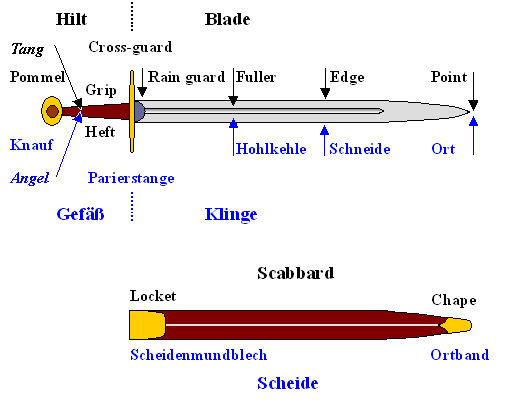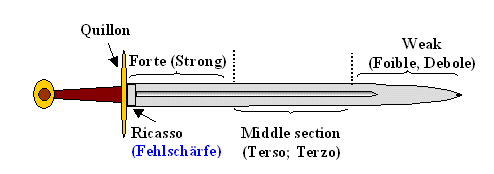Sword Parts
 |
 |
| English Term | Etymology |
|---|---|
| Hilt | Proto-Germanic (included old English): helt (hjalt, helza) = handle of sword, oar, ... |
| Blade | Old English blæd = a leaf. In (modern) German: Blatt = leaf. Includes
leaf-like parts of spades, oars, spears, ... |
| Pommel | From old French early (12th century). Pomel = rounded knob. Goes back to Latin: pomum = apple, connecting
to round things. In Middle-English (ca.1100 - ca.1500) poetry it sometimes means a woman's breast. |
| Tang | From Old Norse (Viking language) tangi = spit of land, pointed metal tool, perhaps related to tunga = tongue |
| Grip | Old English gripe = grasp, clutch; grippan = to grip, seize, obtain. |
| Quillons (other word for crossguard) |
A quillon (singular) is either half of the extended crossguard of a sword or dagger. The term is from Middle French in the late 16th century and is a derivative of quille = bowling pin, ultimately from Old High German kegil = club, stake |
| Fuller | Not so clear. full, ful, fullr, fol, fulls in old languages (modern German: voll
, means simply full. To full = tread or beat cloth to cleanse or thicken it comes from Old French (late 14th century), going back to Latin fullare = to clean cloth (by treading on it). That's why it is is also the root to foul and foiling. A fuller later also meant a half-round hammer used for grooving and spreading iron or a tool or part of a die for reducing the sectional area of a piece of work. |
| Edge | From Old English ecg = corner, edge, point; but it could also just mean "sword". Ecgplega = edge play or ecghete = edge hate, a poetic term for "battle". Modern German Ecke = corner. |
| Point | From Latin pungere = prick, pierce became point in Old French and passed to English around ca.1300. "Puncta" in Medieval Latin, (ca.700 - ca.1500) meant "sharp tip". In modern German Punkt = point, dot, full stop. |
| Forte | The lower third of the blade of a sword, nearest the hilt. It is the strongest part of a blade and is the part used when parrying. |
| Foible , Debole Weak part |
The upper third of the blade, ending in the point. Despite its name, it is the business end of the sword most used to attack. |
| Terso, Terzo Middle Section or |
The middle part of the blade, between the forte and the foible |
| Ricasso | Unsharpened length of blade between the cross guard and the edge. It allows the wielder to place their index finger or a whole hand above the crossguard. The "German "Fehlschärfe" translates literally to "missing sharpness". |
| Scabbard | From Anglo-French (the French written in England from the Norman Conquest (1066) through the Middle Ages; the administrative and legal language of England) escauberc = sheath, vagina. (13 c.). Going back to Frankish (West Germanic language of the Franks, inhabitants of northern Gaul 5 c.-6 c.) skar = blade" + berg = protect. In modern German: verbergen = to conceal, disguise, secrete. |
| Locket | From Old French. loquet = latch. Meaning "ornamental case with hinged cover" (containing a lock of hair, miniature portrait, etc.) first recorded 1670s. |
| Chape | From Latin cappa = cap, hood, cloak. In modern German Kappe = cap. Related to (French) chaperon = protector (of virgins) |
| German Term |
Etymologie |
|---|---|
| Gefäß | A straight translation would be "vessel" but that goes in the wrong direction. It is related to
"fassen" = to hold, to encase. A " Faß" (engl. vat) holds something. Die Stelle and der man das Schwert fasst oder gefasst hat. |
| Klinge | Middle High German. Klingen = to ring, clink, jingle; from the sound of fighting. Klingen ?= hell tönen, erschallen; nach dem hellen Klang des auf Helm und Panzer treffenden Schwertes benannt |
| Knauf | Old German knouf = Knoten (knot). Related to German Knopf = button |
| Angel | ??? The regular meaning is "fishing rod", Sometimes also called Erl |
| Heft | Proto-Germanic heften, heftian, hæftan = stapling, tacking, stiching. Etwas (mit Reißzwecken, Nägeln, Nadeln) befestigen, anbringen, (mit Fäden, Drahtklammern) zusammenfügen. |
| Hilze | Also Gehilze, Griffhilze; from "Holz" = wood. In particular simple wooden grip "stuck" on the tang; as in simple tools. |
| Hohlkehle | Combination of Proto-Germanic (8th c.) hol = hollow, concave, and Old-German (8th c.) kela = channel, flute, groove, throat. |
| Schneide | Proto-Germanic (8th/9th c.) snidan; sniden, snida = to cut with a sharp implement. |
| Ort | The regular meaning is "place", even "town = Ortschaft".
From Old German ort = point, tip. In modern German orten = to locate, to pin down. |
| Scheide | Proto-Germanic skeðia, schede, scede, sceide, nchede = sheath. After the 16th century it also means vagina, taking over the Latin meaning of "vagina" = sheath. |
| Scheidemundblech | Combination of "Scheide" (see above) and Proto-Germanic (8th c.), munt, amund, mont, mond = mouth plus old German bleh = thin metal sheet; related to modern "bleich" = pale, and originally meaning "gleaming, bright, glittering", since mostly gold was hammered into thin sheets. |
| Ortband | Combination of Ort (see above) and old German bant = tie, tape or band. Relates to binding. |